Citroen C1 2014 1.G Workshop Manual
Manufacturer: CITROEN, Model Year: 2014, Model line: C1, Model: Citroen C1 2014 1.GPages: 256, PDF Size: 5.63 MB
Page 51 of 256
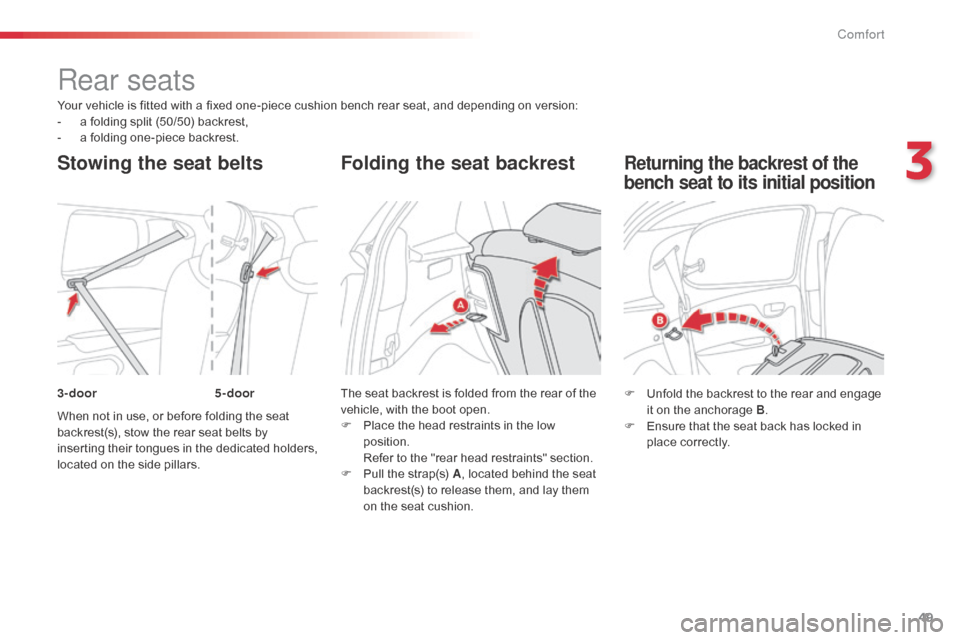
49
Your vehicle is fitted with a fixed one-piece cushion bench rear seat, and depending on version:
- a f olding split (50/50) backrest,
-
a f
olding one-piece backrest.
When not in use, or before folding the seat
backrest(s), stow the rear seat belts by
inserting their tongues in the dedicated holders,
located on the side pillars. The seat backrest is folded from the rear of the
vehicle, with the boot open.
F
P
lace the head restraints in the low
position.
R
efer to the "rear head restraints" section.
F
P
ull the strap(s) A, located behind the seat
backrest(s) to release them, and lay them
on the seat cushion.
Rear seats
Stowing the seat belts Folding the seat backrest
F Unfold the backrest to the rear and engage it on the anchorage B .
F
E
nsure that the seat back has locked in
place correctly.
Returning the backrest of the
bench seat to its initial position
3-door 5-door
3
Comfort
Page 52 of 256

50
Rear head restraints*
The rear head restraints can be removed and
have two positions:
-
h
igh, position for use.
-
l
ow, storage position. To raise the head restraint, pull it upwards.
To lower it, press lug A then the head restraint.
To remove it:
-
t
ilt the seat back slightly,
-
m
ove the head restraint to the high
position,
-
p
ress lug A pulling the head restraint
upwards at the same time. To refit it:
-
t
ilt the seat back slightly,
-
e
ngage the rods of the head restraint in the
openings.
* Depending on version. To put the head restraint in the low position,
press lug A .
Comfort
Page 53 of 256

51
Mirrors
Manual door mirrors
F Operate the lever in four directions to adjust the mirror.
Electric door mirrors
Adjustment
F Move control A to the right or to the left to select the corresponding mirror.
F
M
ove control B in all four directions to
adjust.
F
R
eturn control A to the central position.
The objects observed are, in reality,
closer than they appear.
Take this into account in order to
correctly judge the distance of vehicles
approaching from behind.
Demisting - Defrosting
Use the heated rear window switch.
Refer to the "Rear screen demist - defrost"
section.
Folding / Unfolding
When parking, the mirrors can be folded
manually. The initial adjustments are retained
when unfolding.
3
Comfort
Page 54 of 256
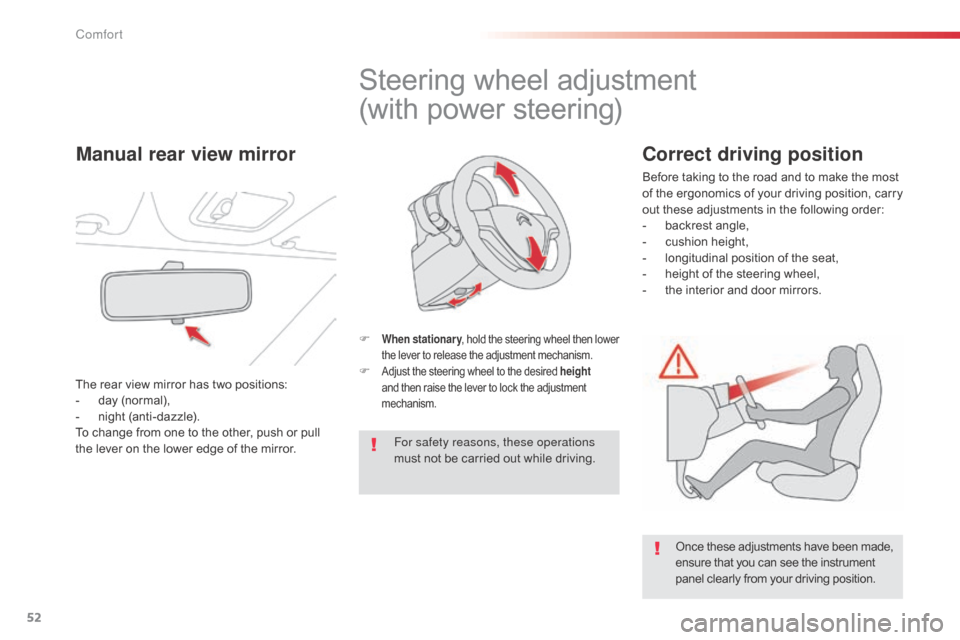
52
Steering wheel adjustment
(with power steering)
F When stationary, hold the steering wheel then lower
the lever to release the adjustment mechanism.
F Adjust the steering wheel to the desired height
and then raise the lever to lock the adjustment
mechanism.
For safety reasons, these operations
must not be carried out while driving.
Once these adjustments have been made,
ensure that you can see the instrument
panel clearly from your driving position.
Manual rear view mirror
The rear view mirror has two positions:
- d ay (normal),
-
n
ight (anti-dazzle).
To change from one to the other, push or pull
the lever on the lower edge of the mirror.
Correct driving position
Before taking to the road and to make the most
of the ergonomics of your driving position, carry
out these adjustments in the following order:
-
b
ackrest angle,
-
c
ushion height,
-
l
ongitudinal position of the seat,
-
h
eight of the steering wheel,
-
t
he interior and door mirrors.
Comfort
Page 55 of 256
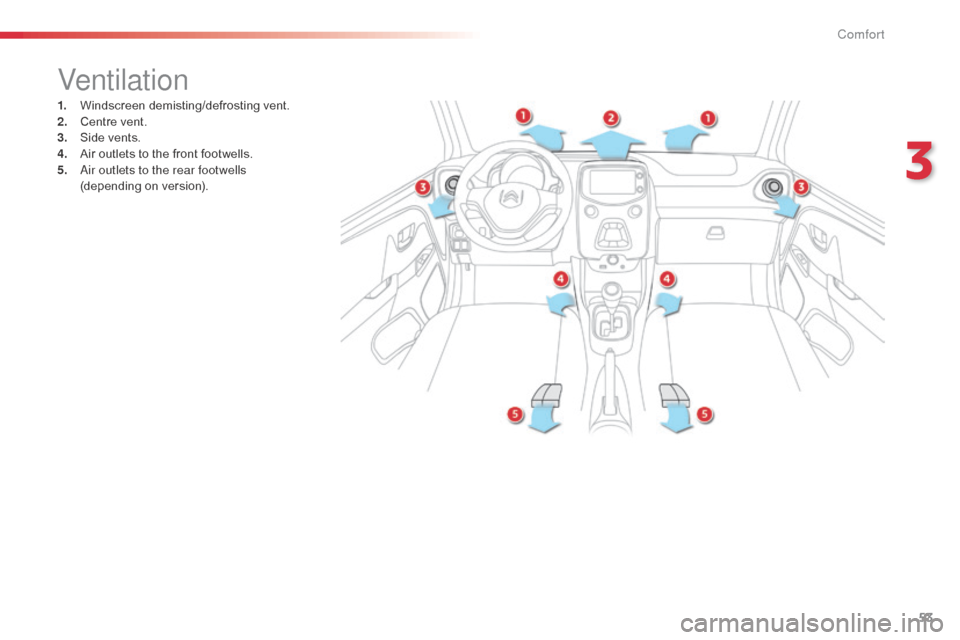
53
Ventilation
1. Windscreen demisting/defrosting vent.
2. Centre vent.
3.
S
ide vents.
4.
A
ir outlets to the front footwells.
5.
a
i
r outlets to the rear footwells
(depending on version).
3
Comfort
Page 56 of 256
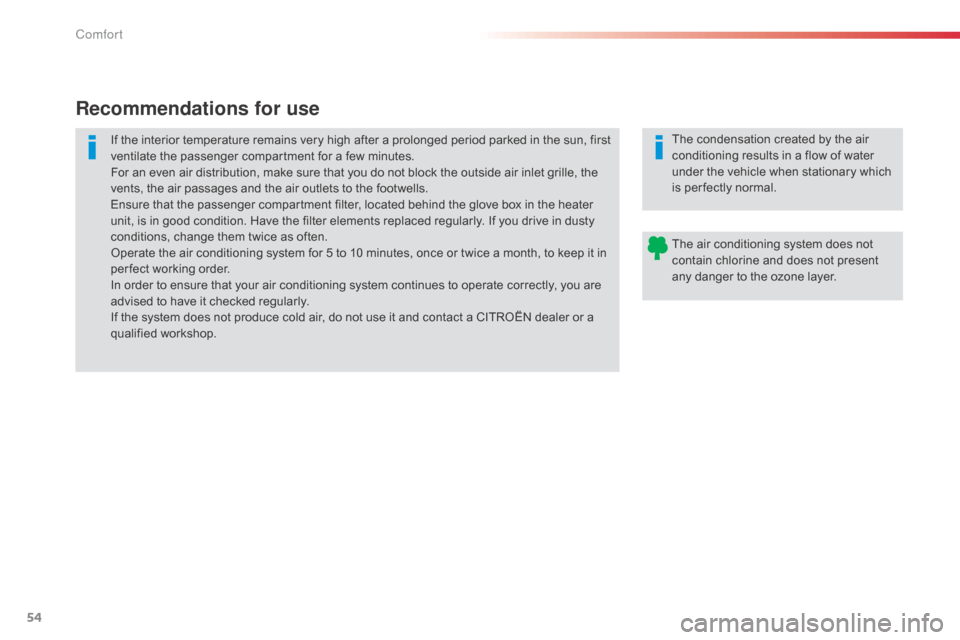
54
Recommendations for use
If the interior temperature remains very high after a prolonged period parked in the sun, first
ventilate the passenger compartment for a few minutes.
For an even air distribution, make sure that you do not block the outside air inlet grille, the
vents, the air passages and the air outlets to the footwells.
Ensure that the passenger compartment filter, located behind the glove box in the heater
unit, is in good condition. Have the filter elements replaced regularly. If you drive in dusty
conditions, change them twice as often.
Operate the air conditioning system for 5 to 10 minutes, once or twice a month, to keep it in
per fect working order.
In order to ensure that your air conditioning system continues to operate correctly, you are
advised to have it checked regularly.
If the system does not produce cold air, do not use it and contact a CITROËN dealer or a
qualified workshop.The air conditioning system does not
contain chlorine and does not present
any danger to the ozone layer. The condensation created by the air
conditioning results in a flow of water
under the vehicle when stationary which
is per fectly normal.
Comfort
Page 57 of 256

55
Heating
The heating system works only when the engine is running.F
T
urn the control from blue
(cold) to red (hot) to adjust the
temperature to your wishes.
Temperature adjustment
Air flow adjustment
F Turn the knob from position 1 to 4 to obtain the desired flow of
a i r.
Avoid driving for too long without
ventilation (risk of misting and
deterioration of air quality).
Air distribution adjustment
Centre vent and side air vents.
Centre vent, side vents and footwells.
Footwells.
Windscreen and footwells.
Windscreen.
The air distribution can be varied by
placing the control in an intermediate
position.
3
Comfort
Page 58 of 256
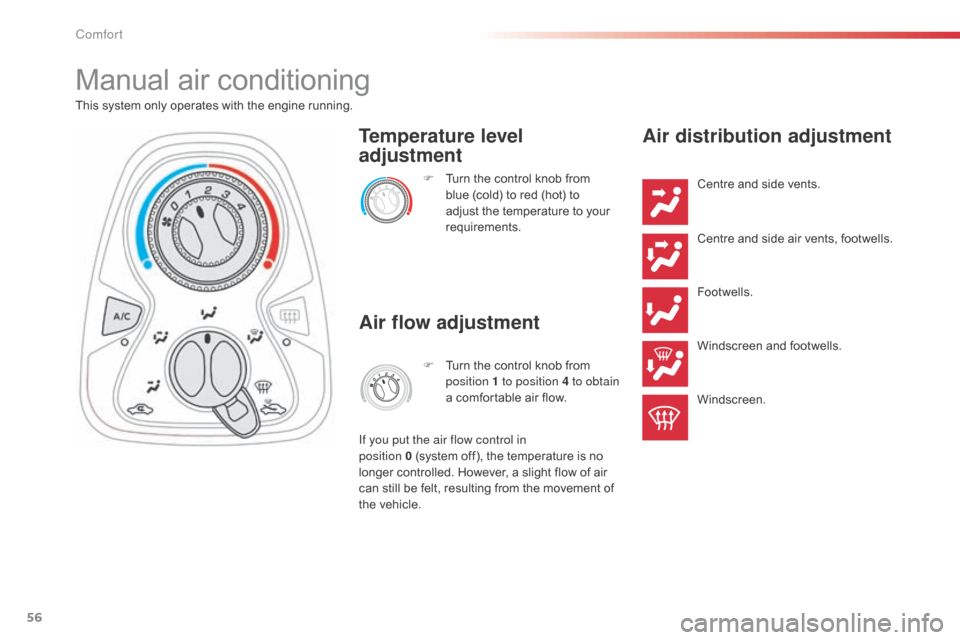
56
Manual air conditioning
This system only operates with the engine running.F
T
urn the control knob from
blue (cold) to red (hot) to
adjust the temperature to your
requirements.
Temperature level
adjustment
Air flow adjustment
F Turn the control knob from position 1 to position 4 to obtain
a comfortable air flow.
If you put the air flow control in
position
0
(system off), the temperature is no
longer controlled. However, a slight flow of air
can still be felt, resulting from the movement of
the vehicle.
Air distribution adjustment
Centre and side vents.
Centre and side air vents, footwells.
Footwells.
Windscreen and footwells.
Windscreen.
Comfort
Page 59 of 256
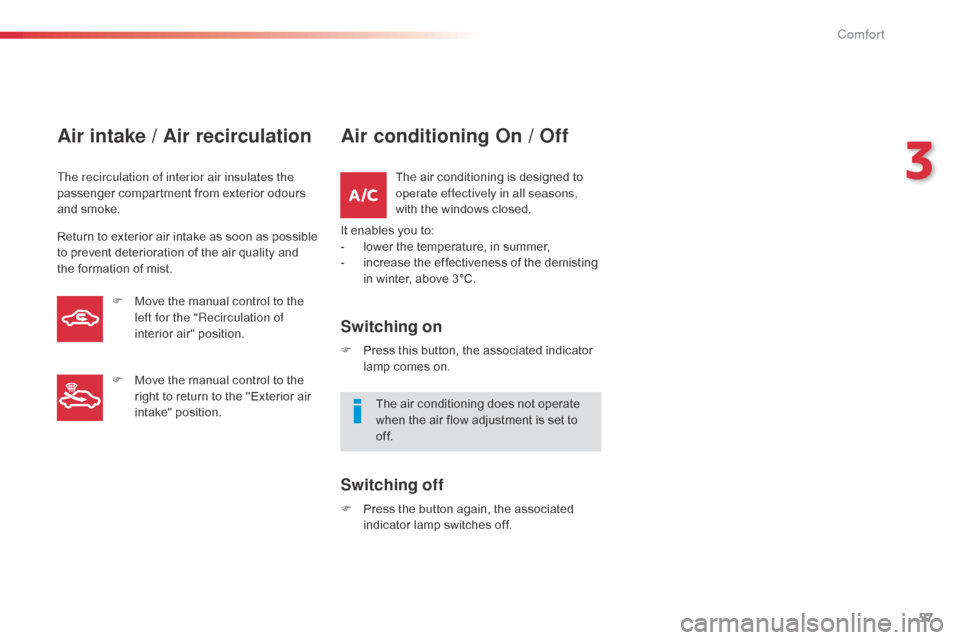
57
Air intake / Air recirculation
The recirculation of interior air insulates the
passenger compartment from exterior odours
and smoke.
Return to exterior air intake as soon as possible
to prevent deterioration of the air quality and
the formation of mist.
Air conditioning On / Off
The air conditioning is designed to
operate effectively in all seasons,
with the windows closed.
It enables you to:
-
l
ower the temperature, in summer,
-
i
ncrease the effectiveness of the demisting
in winter, above 3°C.
Switching on
F Press this button, the associated indicator lamp comes on.
The air conditioning does not operate
when the air flow adjustment is set to
of f.
Switching off
F Press the button again, the associated indicator lamp switches off.
F
M
ove the manual control to the
left for the "Recirculation of
interior air" position.
F
M
ove the manual control to the
right to return to the "Exterior air
intake" position.
3
Comfort
Page 60 of 256
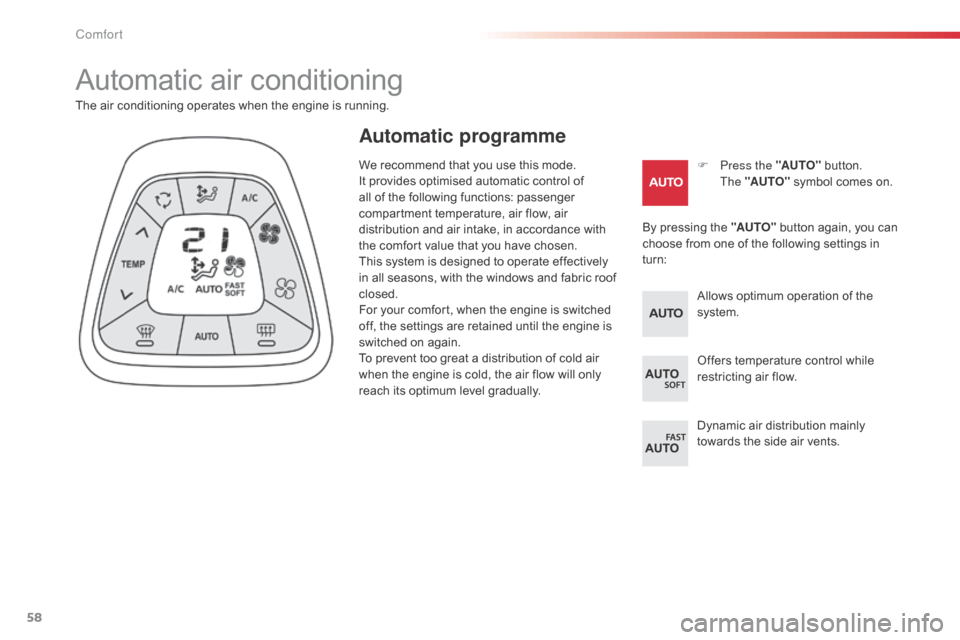
58
Automatic air conditioning
F Press the "AUTO" button.
The "AUTO" symbol comes on.
The air conditioning operates when the engine is running.
By pressing the "AUTO" button again, you can
choose from one of the following settings in
turn:
Automatic programme
Allows optimum operation of the
system.
Offers temperature control while
restricting air flow.
Dynamic air distribution mainly
towards the side air vents.
We recommend that you use this mode.
It provides optimised automatic control of
all of the following functions: passenger
compartment temperature, air flow, air
distribution and air intake, in accordance with
the comfort value that you have chosen.
This system is designed to operate effectively
in all seasons, with the windows and fabric roof
closed.
For your comfort, when the engine is switched
off, the settings are retained until the engine is
switched on again.
To prevent too great a distribution of cold air
when the engine is cold, the air flow will only
reach its optimum level gradually.
Comfort